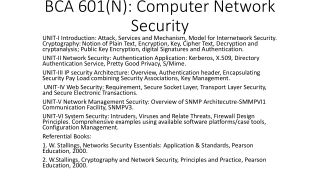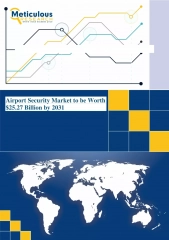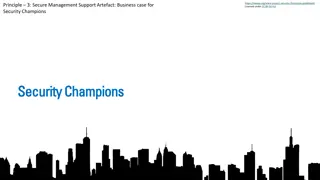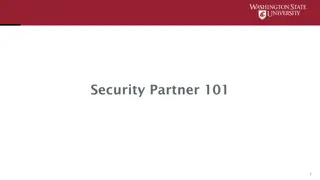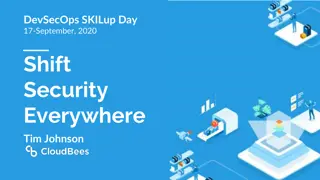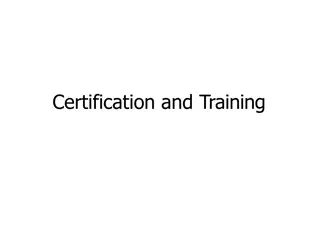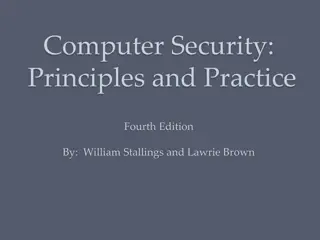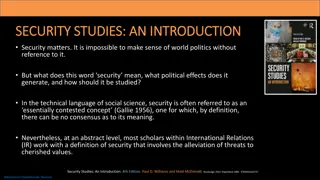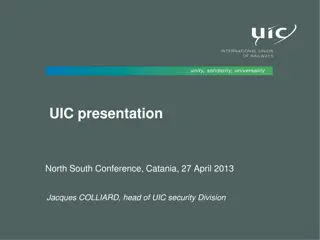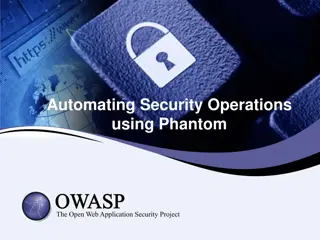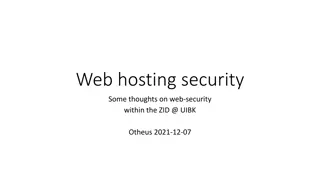Journey into the World of Security with Hamid Nosrati
Explore the fascinating realm of security with Hamid Nosrati, covering topics such as attack types, security standards, CIA triad, common attacks, malware, viruses, social engineering, and more. Learn about the methods, tools, and personnel used to safeguard digital assets, and delve into various cyber attack categories and prevention techniques.
Download Presentation

Please find below an Image/Link to download the presentation.
The content on the website is provided AS IS for your information and personal use only. It may not be sold, licensed, or shared on other websites without obtaining consent from the author.If you encounter any issues during the download, it is possible that the publisher has removed the file from their server.
You are allowed to download the files provided on this website for personal or commercial use, subject to the condition that they are used lawfully. All files are the property of their respective owners.
The content on the website is provided AS IS for your information and personal use only. It may not be sold, licensed, or shared on other websites without obtaining consent from the author.
E N D
Presentation Transcript
TRAVEL TO THE LOVEABLE WORLD OF SECURITY Hamid Nosrati
Intro 1 Attack Type 2 Security Standards 3 Topics Security Jobs 4 How to Start? 5 Q & A 6
Part 1 - Intro Security Definition Security Triad
Security Security for information technology (IT) refers to the METHODS, TOOLS and PERSONNEL used to defend an organization's digital assets.
CIA triad Availability Integrity Security Model Resource always accessible Deals with validity of Data Confidentiality Deals with keeping information, networks and system secure from unauthorized access
Part 2 Attack Types Attack Categories Common Attacks
Attack Types MALWARE BUSINESS EMAIL COMPROMISE PHISHING CROSS SITE SCRIPTING MAN IN THE MIDDLE ATTACK Types of Cyber Attacks ZERO-DAY EXPLOIT Dos/DDos SQL INJECTION
Social Engineering Unwanted App Password Attack Application Attacks Network Attacks Malware Dictionary Attack Race Wireless Attacks Tailgating Virus Spyware Conditions Brute-force Attack Resource Exhaustion Dumpster Diving Worm On-Path Attack Adware Cryptomining Software Shoulder Surfing Trojans Spraying Overflows Layer 2 Attacks Spyware Rainbow Table Code Injections DOS/DDOS Phishing Driver Rootkits DNS Attacks Manipulation Request Forgeries Botnets Directory Traversal Logic Bombs Replay Attack SSL Stripping Pass-the-Hash API Attacks
Malware Malware is software designed to harm a user s computer or data. Viruses To determine whether a system has been infected Memory Worms Registries Trojans Macros Spyware Rootkits Botnets Logic Bombs
Viruses A Virus is a program or piece of code that runs on a computer, often without the user s knowledge and certainly without the user s consent. Viruses are designed to attach themselves to other code and replicate. A virus replicates when an infected file executes or launches. Spread copies of themselves throughout a single machine. They infect other machines only if a user on another machine accesses an infected object and launches the code.
Virus Classification Type A Resident virus Nonresident virus Boot sector virus Macro virus Type B Program-and file-infecting virus Polymorphic virus Armored virus Stealth virus Multipartite virus
Worms Worms are similar in function and behavior to viruses, with one exception: Worms are self-replicating and do not need a host file. If it finds connectivity, the worm tries to replicate from one system to another. are capable of reproducing on their own. Key difference between a virus and a worm is that worms do not need to attach themselves to files and programs and Common methods of replicating include spreading through email, through a network, and over the Internet.
Trojans Trojans or Trojan horses, are programs disguised as useful applications. Trojans do not replicate themselves as viruses do, but they can be just as destructive. and sending data and causing a computer to malfunction. Trojans can perform actions without the user s knowledge or consent, including collecting Backdoor Trojans Exploit Trojans Dropper/downloader Trojans Banking Trojans DDoS Trojans
Ransomware Ransomware is malware that employs encryption to hold a victim s information at ransom. User or organization s critical data is encrypted so that they cannot access files, databases, or applications Ransomware is often designed to spread across a network and target database and file servers, and can thus quickly paralyze an entire organization. Ransomware-as-a-Service
Potentially Unwanted Programs (PUPs) A potentially unwanted program (PUP) is a program that is most likely unwanted, despite the possibility that users consented to download it. Can be Spyware or Adware Undesirable code sometimes arrives with commercial software distributions or downloaded from the Internet Spyware is associated with behaviors such as advertising, collecting personal information, and changing a user s computer configuration without obtaining consent to do so Spyware monitors user activity on the system, potentially including keystrokes typed, and sends this logged information to the originator
Part 3 Security Standards Regulatory and Non-Regulatory Industry-Specific Frameworks
What are Cybersecurity Standards? Cybersecurity standards are collections of best practices created by experts to protect organizations from cyber threats and help improve their cybersecurity posture. Cybersecurity frameworks are generally applicable to all organizations, regardless of their size, industry or sector. Regulatory and Non-regulatory Requirements Regulatory requirements are created by government agencies and are mandated by law. Regulation can exist on an international, national, or local level. The Health Insurance Portability and Accountability Act (HIPAA) of 1996 sets national standards for protecting health information. The Gramm Leach Bliley Act (GLBA) establishes privacy rules for the financial industry. The Payment Card Industry Data Security Standard (PCI DSS) is designed to reduce fraud and protect customer credit card information. The Sarbanes Oxley Act (SOX) governs financial and accounting disclosure information.
Non-regulatory requirements are developed by agencies that develop technology, metrics, and standards for the betterment of the science and technology industry. U.S. non-regulatory organization: National Institute of Standards and Technology (NIST) EU. Non-regulatory organization: European Union Agency for Network and Information Security (ENISA)
Industry-Specific Frameworks PCI DSS Federal Information Security Management Act (FISMA) Health Insurance Portability and Accountability Act (HIPAA) ISO 22301 GDPR NIST SP 800-53 ANSI/ISA 62443
Part 4 Security Jobs Security Jobs Salaries
Security Jobs Cyber Security Analyst Cyber Security Administrator Security Specialist Penetration and Vulnerability tester Incident Responder Security Specialist Malware Analyst Security Manager Forensics Expert Cyber Security Consultant Cyber security Architect Cryptographer Security Software Developer Security Code Auditor Chief Information Security Officer
Cyber Security Analyst Monitor network traffic for security incidents and events Investigate incidents and respond to events in real time Investigating Security Breaches Working With a Team to Locate Vulnerabilities Install and operate firewalls, encryption programs, and other security software Write detailed incident response reports Fix vulnerabilities Salary ~ $70.000 - $80,078 (per year)
Cyber Security Incident Responder Recognize any errors or possible vulnerabilities in the network or system Develop a system of procedures on how to handle an emergency Effectively oversee systems and applications for any suspicious activity Collaborate with other cyber security team members Develop a system for the communication trail that needs to take place during an emergency, and how to relay necessary information to law enforcement Provide well-composed incident reports to proper management team members Run penetration tests, risk analysis and security audits Salary ~ $80.000 - $90,000 (per year)
Cyber Security Malware Analyst Stay up to date on the latest malware and keep software updated to defend against them Record malware threats and identify systems to avoid them Examine programs and software using analysis programs to identify threats Classify malware based on threats and characteristics Understand tools that identify zero-day cyber threats Write alerts to keep the security team informed Help create documentation for security policies Salary ~ $80.000 - $100,000 (per year)
Cyber Security Architect Reviewing current system security measures and recommending and implementing enhancements Conducting regular system tests and ensuring continuous monitoring of network security Developing project timelines for ongoing system upgrades Ensuring all personnel have access to the IT system limited by need and role Establishing disaster recovery procedures and conducting breach of security drills Promptly responding to all security incidents and providing thorough post- event analyses Salary ~ $120.000 - $160,000 (per year)
Security Software Developer Implement, test and operate advanced software security techniques in compliance with technical reference architecture Provide engineering designs for new software solutions to help mitigate security vulnerabilities Perform on-going security testing and code review to improve software security Troubleshoot and debug issues that arise Contribute to all levels of the architecture Maintain technical documentation Consult team members on secure coding practices Salary ~ $90.000 - $120,000 (per year)
Chief Information Security Officer Understand and interact with related disciplines through committees to ensure the consistent application of policies and standards across all technology projects, systems and services Develop, implement and monitor a strategic, comprehensive enterprise information security and IT risk management program Work directly with the business units to facilitate risk assessment and risk management processes Develop and enhance an information security management framework Assist with the overall business technology planning, providing a current knowledge and future vision of technology and systems Partner with business stakeholders across the company to raise awareness of risk management concerns Provide leadership to the enterprise's information security organization Salary ~ $150.000 - $170,000 (per year)
Part 5 How to Start? Recommended Resource


